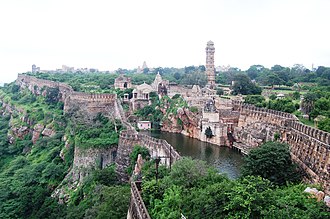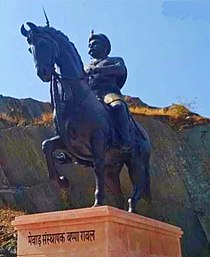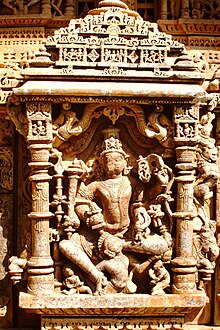Guhila dynasty
During this period, the dynasty started claiming a prestigious origin, stating that its founder Guhadatta (Guhila) was a kshatriya who was bought up in a Nagda Brahmin household and had migrated from Anandapura (present-day Vadnagar in Gujarat).R. C. Majumdar theorizes that Bappa achieved a highly significant military success, because of which he gained reputation as the dynasty's founder.However, Somani dismisses this theory, arguing that Rama here refers to Ramachandra, from whose Solar dynasty (or Suryavansh) the later Guhilas claimed descent.[14] The later bardic chronicles mention a fabricated genealogy, claiming that the dynasty's founder Guhaditya was a son of Shiladitya, the Maitraka ruler of Vallabhi.R. V. Somani theorizes that the copper and zinc mines at Jawar were excavated during his reign, which greatly increased the economic prosperity of the kingdom.The 16th century Buddhist writer Taranatha mentions a reputed artist named Shringadhara, who was patronized by the king Shila of Maru country.[23] In the later half of the 10th century, the Paramara king Munja defeated the elephant forces of the Guhilas, and plundered their capital Ahar.By 1182,[23] Samantasimha's younger brother Kumarasimha regained the control of his ancestral kingdom by appeasing the Chaulukya king Bhima II.He was aided by Sambhar-Ajmer ruler Prithviraja III with whom he fought against the Ghurid conqueror Muhammad of Ghor in Second Battle of Tarain.[31] He fought with multiple rulers like Turushkas at Naddula[32] which was possible held by Ghurid dynasty who captured it from Chauhans,[32] Tribhuvana-Ranaka (identified with the Chaulukya king Tribhuvanapala) at Kottadaka,[33] Iltutmish invaded Mewar, and destroyed Nagada.Sometime before 1285, Samarasimha helped Sarangadeva repulse a Turushka (Turkic) invasion of Gujarat (possibly a Delhi Sultanate army during Balban's reign).[31] His Chirwa inscription states that he "like unto the primaeval boar [...] in a moment lifted the deeply sunk Gurjara land out of the Turushka sea".[34] Towards the end of the 13th century, when Alauddin Khalji's army invaded Gujarat, Samarasimha saved his kingdom by paying a tribute.[35] The Rana branch survived in form of the Sisodia dynasty which continued to rule Mewar till Independence of India from British control.[43] The 1460 Kumbhalgarh inscription of Kumbhakarna states that after Ratnasiṃha departed from the battlefield (during the 1303 Siege of Chittor), Lakshmasiṃha of the Rana branch died fighting to defend the fort.According to the 1652 Eklingji inscription, Rahapa's successors were:[45] Hammir Singh re-established the family's rule over Mewar under the title of Rana.




Gohil dynastyKingdom of MewarRawal GuhilMahendra Singh MewarRatnasimhaBhupal SinghChittorHouse of SisodiaRajasthanGurjara-PratiharaRashtrakutasGuhilasRawal Bharttripatta IIRawal AllataKingdom of MalwaKingdom of SambharDelhi SultanateChaulukyasKingdom of GujaratChittorgarh1303 Siege of ChittorgarhSisodiaRajputMaharajadhirajaGuhadatta (Guhila)kshatriyaBrahminVadnagarChittor FortSiege of Chittorgarh (1303)Bappa RawalPashupataR. C. MajumdarAchaleshwarD. R. BhandarkarG. H. OjhaParashuramaD. C. SircarRamachandraSolar dynastySuryavanshMaitrakaVallabhiEklingjiVishnuTaranathaHarshavardhanaGurjara-PratiharasBharttripatta IIAllataSahasra Bahu TemplesNagda, RajasthanParamaraRashtrakutaChahamanaVakpati IIUdayadityaKalachuriGayakarnaEklingaRanasimhaChaulukyaKumarapalaSamantasimhaAjayapalaprashastiGurjaraNaddula ChahamanaKirtipalaSamantasimha'sBhima IISambhar-AjmerPrithviraja IIIGhurid conquerorMuhammad of GhorSecond Battle of TarainJaitrasimhaTurushkasNaddulaGhurid dynastyTribhuvanapalaIltutmishShakambhariChahamanas of RanthamboreJaitrasimha'sTejasimhaSamarasimhaVaghelaTurushkaBalbanprimaeval boarAlauddin Khaljiinvaded GujarattributeIndependence of IndiaSamarasiṃhaAchaleshvarSadadiKumbhakarnaKumbhalgarhKālabhojaBhartṛipaṭṭaAllaṭaBuddhistsShaivite HindusRaṇasiṃhaSāmantasiṃhaJaitrasiṃhaVāgaḍaTejasiṃhaRatnasiṃhaSamarasiṃha'sHammīra1303 Siege of ChittorHammiraN. P. ChakravartiPeter Jackson